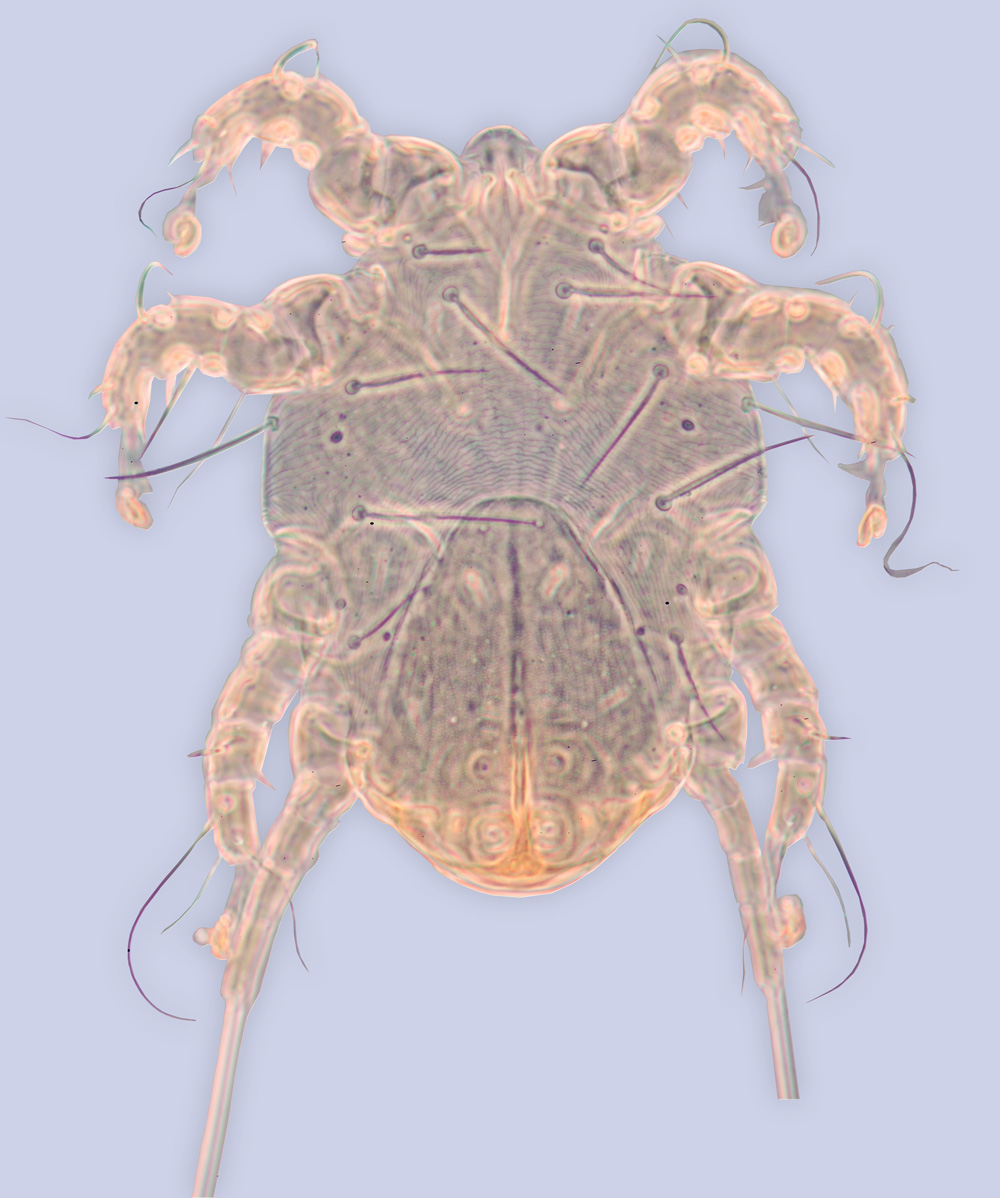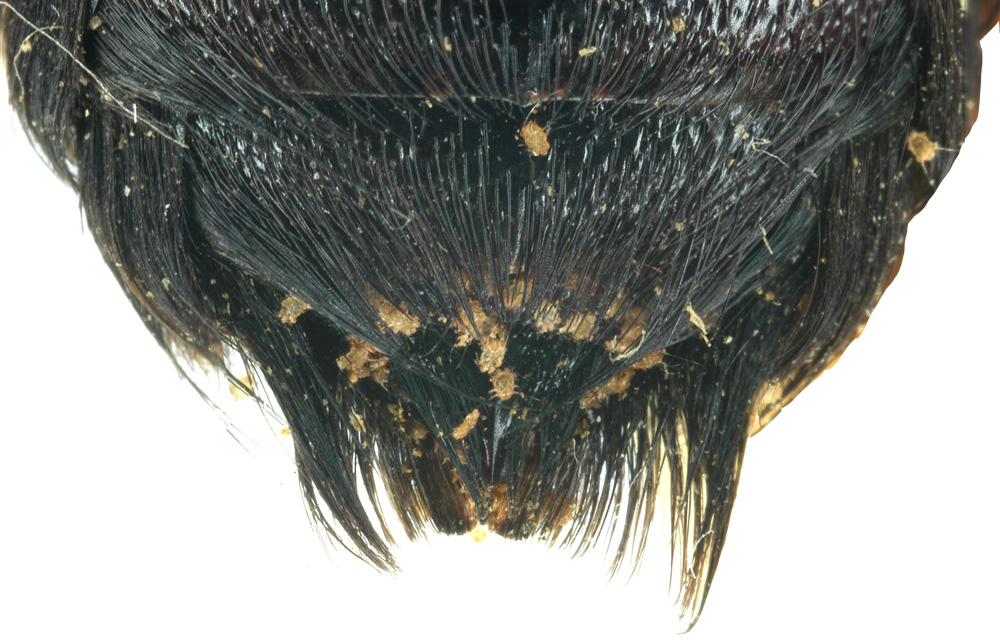
Fig. 1. Phoretic deutonymph of the mite Sennertia argentina, ex Xylocopa mexicanorum, Mexico (BMOC 05-0102-027).
Click here to enlarge
|

Fig. 2. Phoretic deutonymph of the mite Sennertia argentiana, emerging from the genital acarinarium of the bee Xylocopa frontalis, Panama (BMOC 04-1222-157).
Click here to enlarge
|
Bee Mites : Acari : Acariformes : Sarcoptiformes : Chaetodactylidae : Sennertia : Sennertia species
Sennertia argentina Vitzthum, 1941
Sennertia argentina Vitzthum, 1941: 309, Fig. 2 (Lectotype HDN A20031417-18, 2 paralectotype HDNs labeled as Sennertia argentina in ZSMC A20031417, A20032894 (Jürgen et al., 2005)); Klimov & OConnor, 2008: 156, Figs 78-79.
Sennertia (Spinosennertia) argentina: Fain, 1981a: 176, Figs 49, 51 (lectotype designation, synonymized with Sennertia donaldi F. Turk, 1948) (part.); Alzuet & Abrahamovich, 1987: 350 (part.); OConnor, 1993a: 362 (part.); ?Haitlinger, 1999: 59 (part., record from Guatemala, ex Passalidae); Klimov et al., 2007b: 129 (diagnosis, included in key).
Material (show database records). HDN - Amazonas, Tapuruquára (Santa Isabel do Rio Negro), ex Xylocopa frontalis on propodeum, 1 Jun 1963, L. Guindani, USNM, BMOC 05-0420-197; 1 HDN - BRAZIL: Mato Grosso do Sul, Aquidauana, 11 Dec 1919, Cornell University Expedition, ex X. frontalis, CUIC, BMOC 74-0812-001; 4 HDNs - R. Putamayo, Pto. America, 30 Aug-2 Sep 1920, Cornell University Expedition lot#569, ex X. frontalis, UMMZ, BMOC 04-0914-001; 6 HDNs - Goiás, 24 km E Formosa, 16 May 1956, F. S. Truxal, ex f X. frontalis (over body) LACM ENT 208600 BMOC 05-0102-036; 2 HDNs - same data, LACM ENT 208601, BMOC 05-0102-037; 5 HDNs - COSTA RICA: Cartago, Cartago, no date and collector, ex X. fimbriata (male) CUIC, HK 84-0827-004; 24 HDNs (6 slides) - Cartago, 2.5 km E 4 km N Chitaría, ex X. frontalis on propodeum, 13 Aug 1965, R. D. Sage, USNM, BMOC 05-0420-198; 6 HDNs - Guanacaste, Lomas Barbudal Biological Reserve, area B, ex X. fimbriata (female reproductive tract), Feb. 1988, 1989, S. B. Vinson, UMMZ, BMOC 80-1215-001; 2 HDNs - GUATEMALA: Suchitepéquez, Variedades, Finca, 500 ft., 27 Aug 1947, F. Johnson, ex X. frontalis (mesosoma), AMNH, BMOC 04-0508-318; 3 HDNs - MEXICO: Sinaloa, Escuinapa de Hidalgo, no date, J. H. Batty, ex X. frontalis (mesosoma), AMNH, BMOC 04-0508-316; 13 HDNs - Chiapas, Simojovel de Allende, 12 Aug 1958, J. A. Chemsak ex X. nautlana (male, ventral metasoma, including genital area), FMNH, BMOC 03-1008-056; 5HDNs - Jalisco, Chamela, ex X. mexicanorum genital area, 18 Jun 1981, S. Bullock, LACM ENT 208591, BMOC 05-0102-027; 16 HDNs - NICARAGUA: Rivas, San Juan del Sur, 10 Jan 1936, Zaca Exped 37483, ex X. frontalis, AMNH, BMOC 04-0508-317; 18HDNs - PANAMA: Albrook Field, Canal Zone, ex X. frontalis (orig: frontalis viridimicans), on 1st metasomal tergite, 20 Mar 1938, L. Stannard, Jr., INHS Insect Collection 62497, BMOC 04-1222-157; 2 HDNs – same locality, X. frontalis, on 1st metasomal tergite, 20 Mar 1938 L. J. Stannard INHS Insect Collection 62341, BMOC 04-1222-004; 18HDNs - Lake Alajuela, ex X. nasica all on 1st metasomal tergite, 29 May 1912, A. Busck, USNM, BMOC 05-0420-292; 4 HDNs - PERU: Loreto, Iquitos/San Roque, Jan 1929, Klug, ex X. frontalis (male) CUIC, HK 84-0820-004; 10 HDNs - Pucallpa, 200 m., ex m X. frontalis on 1st metasomal tergite, 1 Jan 1965, J. Schunke, LACM 208298, BMOC 04-1122-027; 6 HDNs - SURINAME: Marowijne Cottica R., Moengo, 12 May 1927, no collector X. frontalis (male) CUIC, HK 84-0820-001; 15 HDNs – UNKNOWN [?COLOMBIA]: El Reposo, ex X. fimbriata genital area, no date, Champion, INHS Insect Collection 62496, BMOC 04-1222-156.
Description. Phoretic deutonymph. Gnathosomal solenidia shorter than 1/3 of femur I width. Supracoxal setae scx situated on separate small sclerite. Hysterosomal shield lateral gland openings and bases of f2 nearly on edge of hysterosomal shield, or the former outside the shield. Lateral edges of hysterosomal shield in anterior part distinctly narrowing. Dorsal hysterosomal pouch absent. Distance between anterior margin of hysterosomal shield and setae si exceeds diameter of si bases. Striate pattern of idiosomal cuticle outside hysterosomal shield without sclerotization, formed by long striae. Distinct rudiments of vi present. Setae si distinctly posterior se, exceed 1/2 of se, almost as thick as se. Diameter of si exceeds 1/2 of diameter of se. Setae c1 and d1-h1 uniform in length, microsetae. Setae c1 microsetae, situated anterior to hysterosomal shield. Setae d1 and e1 nearly uniform in length with h1. Setae d1 situated on hysterosomal shield. Sclerite between ia and d2 absent. Setae e2 subequal with d2; not touching hysterosomal shield. Setae h3 shorter or nearly equal to legs IV. Lateral gland openings situated outside hysterosomal shield. Setae 1a, 3a, 4a attenuated. Setae 4b, g, and 4a without distinct rhomb-like widening but widened otherwise (spiniform or nearly spiniform). Setae 4b, pR I-II, sR III, wF IV, gT I-II, hT I-II, kT III, ra I-II, and wa I-II spiniform. Posterior apodemes II and anterior apodemes III free. Anterior apodemes IV not interrupted, arc-like. Posterior apodeme IV present, not connected to anterior apodeme III. Conoids ps2 posterior to anterior transverse level of central suckers (ad1+2); anterior to ps1, situated outside outer level of ad1+2. Transparent margin of anterior suckers (ad3) without rough sclerotization. Suckers ad3 enlarged. Posterior and lateral borders of attachment organ not forming distinct frame. Sclerotized rudiment of anterior cuticular suckers present. Longitudinal hysterosomal sclerite present, long. Ventral hysterosoma smooth. Genual setae mG I-II simple, mG II distinctly shorter than leg II, but longer than femur II. Tarsal setae la I-II microsetae, as long as famulus ε. Tarsal setae ra I-II not bifid, spiniform. Tarsal setae wa I-II and s III spiniform (at least s III with rounded apices). Tarsal setae d I-II distinctly widened, lanceolate. Tarsal setae d and f I-II strongly asymmetrical, f about 2 times shorter and filiform, e longer and lanceolate; d and f I not touching. Solenidion ω3 closer to f I than to ω1. Posterior condylophore absent. Anterior condylophore I-II without distal bending. Seta d III situated shifted from tarsal base, distance distinctly exceeding diameter of d III alveolus. Leg IV protruding posterior edge of hysterosoma. Tarsus IV not enlarged, shorter or less than 2 times longer than width of trochanter IV. Setae w IV thinner than d IV and distinctly shorter than leg IV, situated on middle of tarsus IV. Setae s IV present. Setae wF IV shorter than femur IV.
Other instars unknown.
Hosts. Xylocopa (Neoxylocopa) frontalis (type host), Xylocopa (Neoxylocopa) fimbriata, Xylocopa (Neoxylocopa) nautlana, Xylocopa (Neoxylocopa) nasica, Xylocopa (Neoxylocopa) mexicanorum (Apidae).
Distribution (Show map). Argentina (type locality); Brazil; Costa Rica; Guatemala; Mexico: Jalisco, Sinaloa, Chiapas; Nicaragua; Peru; Panama; Suriname.
Biology. Frequently found phoretic in and around genital capsules of host males, numerous deutonymphs were also found in a special pouch (genital acarinarium) of the female genital system (Klimov et al., 2007b).
References
Alzuet, A. B. d. & A. H. Abrahamovich. 1987 [1985]. Deutoninfas (hypopi) de los géneros Sennertia Oudemans, 1905 y Horstia Oudemans, 1905 (Acari: Astigmata) sobre Xylocopa (S.) splendidula splendidula Lepeletier, 1841 (Hymenoptera: Apoidea). Revista de la Sociedad Entomologica Argentina.44: 345-351.
Fain, A. 1981. A revision of the phoretic deutonymphs (hypopi) of the genus Sennertia Oudemans, 1905 (Acari, Astigmata, Chaetodactylidae). Systematic Parasitology.3: 145-183.
Haitlinger, R. 1999. Sennertia herminae sp. n. (Acari, Astigmata: Chaetodactylidae) a phoretic mite associated with Xylocopa sp. (Hymenoptera: Anthophoridae) from Madagascar. Folia Entomologica Hungarica.60: 57-59.
Jürgen, R. H., E. Boos, T. Ludwig, M. Wiedemann & T. Stützel. 2005. SysTax - a Database System for Systematics and Taxonomy. http://www.biologie.uni-ulm.de/systax/ (accessed Sep 2005).
Klimov, P. B. & B. M. OConnor. 2008. Morphology, evolution, and host associations of bee-associated mites of the family Chaetodactylidae (Acari: Astigmata), with a monographic revision of North American taxa. Miscellaneous Publications Museum of Zoology University of Michigan.199: 1-243.
Klimov, P. B., S. B. Vinson & B. M. OConnor. 2007. Acarinaria in associations of apid bees and chaetodactylid mites. Invertebrate Systematics.21: 109-136.
OConnor, B. M. 1993. Generic relationships in the Chaetodactylidae (Acari: Astigmata) with description of a new genus. Acarologia.34: 345-362.
Vitzthum, H. 1941. Über den Symphorismus einiger unbekannter Tyroglyphiden-Deutonymphen. Zeitschrift fur Parasitenkunde.12: 307-316.
B. OConnor and P. Klimov ©
Created: May 26, 2011
Last modified: 
